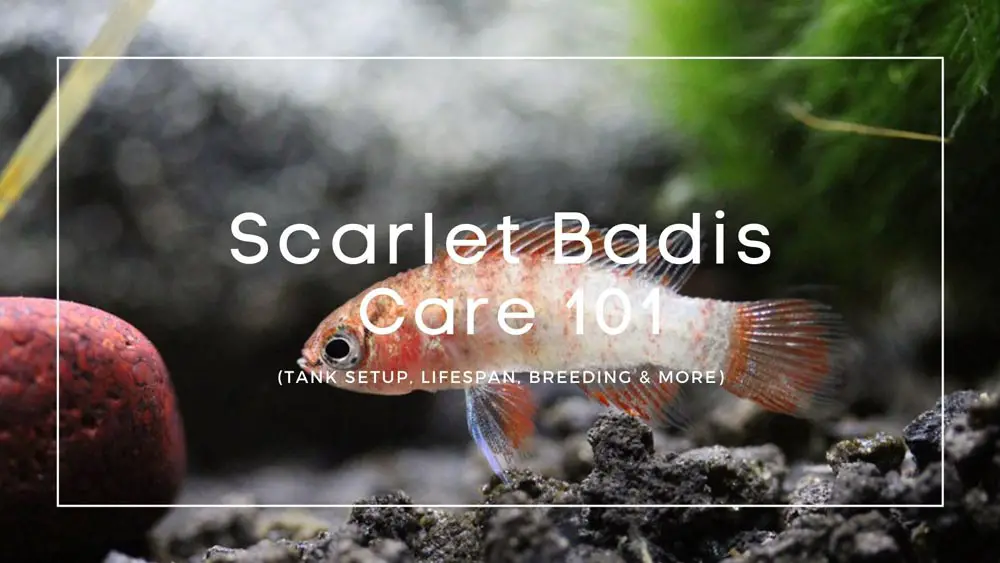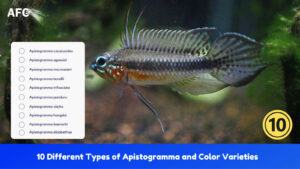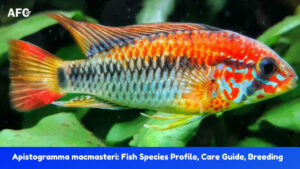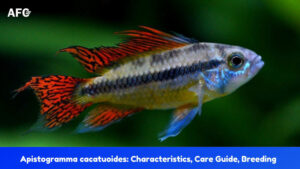The scarlet badis has become a trendy freshwater fish, as well as one of the most popular nano fish available today. Their behavior, activity level, and beauty make this fish a fun one to observe. They are also easy to take care of and keep healthy, although they do present some challenges in how they are cared for.
Having said that, you should still be aware of some important conditions to the scarlet badis’ care if you want them to thrive in your tank stress-free. Their water cleaning conditions and feeding habits can be a little demanding for beginner aquarists. They are best suited for intermediate aquarists.
This care guide will take you through all the do’s and don’ts about caring for your scarlet badis. We will recommend the perfect tank mates, as well as what they should and should not eat, their water conditions, and much more.

Species Profile Overview
One of the smaller known percoid species of fish, the scarlet badis, or Dario dario as it’s known scientifically, is a tropical freshwater Badidae fish. It prefers to feed on small worms, zooplankton, insect larvae, and other small aquatic crustaceans.
Very popular with the nano aquarium population, the attractive little scarlet badis is also sold under the names of B. bengalensis, and Badis badis bengalensis.
The scarlet badis is a native of India, found in the tributaries that feed into the Brahmaputra river. The Brahmaputra is a large river that flows through Bangladesh, China, and India. They love to inhabit areas where there is a large quantity of plant life, as well as clear, shallow water.
Behavior
The scarlet badis is a calm and slower-moving fish than most. Being a bit shy and fond of being on their own, they tend to be intimidated easily and lose to more aggressive and larger tankmates when it comes to food.
Because this is a timid fish, it needs an aquarium with lots of dense vegetation in order to provide it with the protection it needs to help it feel secure. The scarlet badis will spend a lot of its time slowly swimming around the bottom and middle regions in the tank, staying hidden in the vegetation.
Although the scarlet badis is a timid and peaceful fish, it will become very territorial and aggressive towards other scarlet badis fish. If you put more than one male in the tank, they could become rivals and start being hostile to one another, especially in smaller aquariums.
For smaller aquariums, it’s best to only have one male and a female, or one male and several females, but no more than one male scarlet badis in the tank. If you do want other tankmates, it’s best to stick with small pelagic species.
However, in the bigger aquariums, it is possible to have a group of males coexist as long as there is enough space for each male to have its own territory. A tank with plenty of caves thoughtfully spread out and separated from each other. It would be best if you did not cluster the available spawning areas together.
Appearance
This beautiful little fish has been compared to a flashing jewel, or a ruby, swimming about your tank.
Sporting more prominent fins and vibrant colors, the male of this species is more beautiful than that of the female. The males do not surpass 2 cm in size (0.79 in), whereas the females only reach approximately 1.3 cm in size (0.51 in).
The male scarlet badis gets its vibrant colors from seven vertical iridescent blue stripes, spaced out evenly, on its sides that start near the dorsal fin. There will also be some light blue that fades into the base of their caudal and dorsal fins, but it will be more pronounced on the ventral fins that hang lower than the others.
As they grow, the males develop extended anal, pelvic, and dorsal fins. Their accented colors create a flickering effect as they swim, which is beautiful and mesmerizing to watch.
The females are smaller in size and not as colorful as the males. They lack the blue, red, and orange pigmentation on their sides, with either a couple of slim pale orange vertical stripes or no stripes at all on their sides, as well as transparent fins. Their short silvery-grey bodies are also stumpier-looking than males, and their fins are less colorful and noticeable as they are on the adult males.
Tank and Water Conditions
Due to their small size, the scarlet badis is a trendy choice for the nano aquariums. Still, a tank around 10 gallons, filled with plants and vegetation, would be perfect for them to spread out and claim their territories to hide within.
Because their natural environment is in shallow, crystal clear water that has dense vegetation along with a gravel and sand substrate, you should remember to use a variety of plants when creating the tank so that the scarlet badis will feel comfortable and establish their territories. Plants from its natural environment that do well in an aquarium are Rotala, Cryptocoryne spp., Vallisneria, Microsorum, Ottelia, Anubias, Limnophila, Taxiphyllum, and Hygrophila. Water plants, like water sprite and java moss, as well as bogwood, make perfect hiding spots.
Previously stated, the scarlet badis is a very territorial fish. Because of this, they need caves and plants to help stop aggressive reactions or attitudes toward one another by allowing them to set their own territories. The abundance of vegetation and plants will also keep the scarlet badis from growing frightened.
For this fish, the aquarium’s water condition is very important and should be maintained at safe levels for the scarlet badis:
- The water temperature should be between 71 and 79°F
- The pH range should be between 6.5 and 7.5
- The hardiness level should be between 10 to 20 dGH
- The water movement should be slow
- The lighting should stay moderate
You must replace the water frequently and keep it crystal clean because the scarlet badis is susceptible to pollution. You should change out at least half of the tank’s water and clean your aquarium on a weekly basis to keep your fish healthy.
The scarlet badis is best maintained in a well-structured environment with plenty of hiding places. For the bottom of the tank, a soft substrate such as sand is preferable, but fine-grade gravel is satisfactory, as well.
Food & Diet
By replicating their natural diet in the wild as much as possible, your scarlet badis will be healthy and happy. A diversified and well-balanced diet is the best way to see that they thrive in their aquarium.
Being picky eaters, they will not eat flake foods. Sometimes they will eat the small-sized pellets, but only if they are sinking or moving around in the water. Instead, being micro predators, the scarlet badis prefers to dine on live or frozen foods. Their favorites include insect larvae, banana worms, grindal worms, brine shrimp, cyclops, small crustaceans, daphnia, and other small zooplankton.
Because this species is susceptible to diseases and obesity, low quality food needs to be avoided. The bloodworm and Tubifex should be avoided in their diet because they tend to encourage diseases in the scarlet badis.
Tank Mates
In its natural habitat, you can find the scarlet badis swimming in the thick vegetation that grows near the river shores, sharing their space with similar species, such as the badis kanabo and the badis blosyrus.
It is best if the scarlet badis is kept in a tank inhabited by its species only because of the extremely shy and timid nature they exhibit. Because of this timid nature, more active and larger fish will end up out-competing them for space and food. If their tank mates are too active, it will cause the scarlet badis to hide and not come out at dinner time to eat. Avoid such fish as cichlids, goldfish, and bettas due to their aggressive nature.
It would be best if you were more selective when choosing their tankmates if you decide on a community aquarium. Make sure you put them with similarly small, peaceful fish like a small shoal of gouramis or Rasboras. Your only concern with a shoal is to make sure your scarlet badis gets enough food.
Because the scarlet badis is a micro predator, you should avoid putting non-fish tank dwellers such as snails and shrimp with them. Otherwise, they will eat them
Scarlet Badis Special Care Advice
Although there aren’t any specific diseases that can be attributed to the scarlet badis, they can be prone to some general illnesses. Because this fish has a severe sensitivity to the wrong water conditions, they can be susceptible to ich, along with several forms of bacterial and fungal diseases, also.
Medical Definition of ich. : a severe dermatitis of freshwater fish caused by a protozoan of the genus Ichthyophthirius (I. multifiliis) and especially destructive in aquariums and hatcheries. — also called ichthyophthiriasis, ichthyophthirius.
By maintaining the correct water quality, you lower the chances of afflicting your fish with any of these conditions dramatically. Remember, it’s always best to prevent sickness so that you don’t end up needing to treat the sickness.
Breeding
Having been successfully bred in both slightly acidic waters and alkaline waters, breeding the scarlet badis is pretty routine. Dense vegetation gives them places to spawn their eggs.
If there are multiple males in the tank, you will need to give each about 30 cm² in order to establish its own territory. Usually, one male will become more dominant than the others, causing the others not to be involved in the breeding process.
The males will show off their bright colors to the females when the spawning begins. By quivering and shaking, the males begin to attract the females to their territory. The females must respond to the males’ attempts. Otherwise, they will attack the female and chase her away.
When she is ready to spawn, she will go into his territory and allow him to mate with her, quite similar to how the Bettas do it. The male will then fertilize the spawned eggs while they are being laid by the female.
It takes around an hour for the female to lay approximately 80 large eggs. After this, the male chases the female away and will then begin to protect and defend the area, caring more about its territory than the eggs.
The spawned eggs have an incubation period of about 2 to 3 days, with up to one week for the fry to absorb the sac of the egg yolk. If you want to make sure you get the maximum number of fry raised, you should either remove the adults to another tank because once the fry have hatched the adults will start preying on them. Or, you can remove the surfaces the eggs attached to and place them in a separate tank with water from the spawning tank to keep them safe from being eaten.
After hatching, the larvae will disappear for several days before reappearing as juveniles. At this time, the fry will begin to swim around on its own, as well as feed on its own, eating microorganisms they find amongst the vegetation. If you want, you can feed the fry infusoria until they grow big enough to eat food, such as micro worms.
Conclusion
Planting dense vegetation in the tank will allow them to establish their individual territories, making them feel sheltered and safe. Being fussy eaters, they will ignore flake food, but with live and frozen foods, they could become obese.
Jewel-like, the scarlet badis will add beautiful colors to your tank. Just remember that even though they appear timid and peaceful, they are very aggressive towards one another.
While they do best in a species only tank, they will thrive in a community tank as long as you follow the guidelines in this care guide and give them plenty of vegetation and space to establish their own territories.





